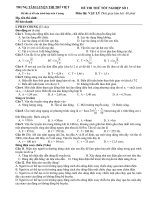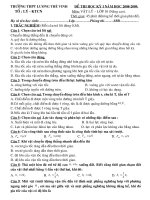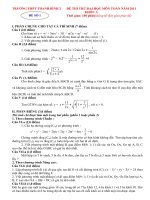Đề thi 20% lý thuyết dịch số 1 (1)
Bạn đang xem bản rút gọn của tài liệu. Xem và tải ngay bản đầy đủ của tài liệu tại đây (0 B, 4 trang )
HANOI OPEN UNIVERSITY
MID -TERM TEST ON TRANSLATION THEORIES
FOR STUDENTS OF ENGLISH (No 1)
Subject Code: EN43
BÀI GIẢI
Full name: ………………………………...............
Date of birth: ………………………………...........
Group: …………………………………….............
I. Answer the following questions: (40 points)
1. What are the different current views on translation?
2. What is Nida's general theory of translating?
(The file sent will be named after each student’s name. Plagiarism will lead to failure)
1. Different Current Views on Translation:
There are various views and approaches to translation, each reflecting different
philosophies and methodologies. Some of the current views on translation include:
a) Formal Equivalence (Literal Translation): This approach emphasizes word-for-word
translation, preserving the grammatical structures and cultural elements of the source text
as closely as possible. It aims for accuracy and fidelity to the original, sometimes at the
expense of naturalness in the target language.
b) Dynamic Equivalence (Functional Equivalence): This approach focuses on conveying
the meaning and intent of the source text rather than adhering strictly to the form. It
allows for more flexibility and adaptation in the target language to ensure the message is
effectively communicated to the target audience.
c) Communicative Translation: This view emphasizes the importance of considering the
context, audience, and communicative purpose of the translation. It aims to produce a text
that achieves the same communicative function as the source text, even if it requires some
modifications.
1
d) Cultural Translation: This approach recognizes the cultural differences between the
source and target languages and aims to make the translation culturally appropriate for the
target audience. It involves adapting cultural references and idiomatic expressions to
ensure comprehension and avoid potential misunderstandings.
e) Postcolonial Translation: This perspective addresses the power dynamics in translation,
particularly in postcolonial contexts. It seeks to challenge dominant discourses and
decolonize translation by giving voice to marginalized groups and cultures.
f) Descriptive Translation Studies (DTS): DTS analyzes translations as a social and
cultural phenomenon, focusing on how translations are produced, received, and function
in various contexts. It aims to describe and understand translation practices rather than
prescribe normative rules.
2. Nida's General Theory of Translating:
Eugene Nida, a prominent translation scholar, proposed a general theory of translating
that emphasizes the importance of effective communication in translation. His theory is
known as the "Dynamic Equivalence" or "Functional Equivalence" theory. According to
Nida, the primary goal of translation is to convey the meaning and message of the source
text in a way that is natural and understandable to the target audience.
Nida's theory rejects the idea of strict word-for-word translation and emphasizes the need
to consider the dynamic relationship between the source and target languages. He
introduced the concept of "dynamic equivalence," which involves translating the content,
functional meaning, and style of the source text rather than focusing on its literal form.
Nida advocated for a translation process that takes into account the cultural, linguistic,
and social context of both the source and target languages. He emphasized the importance
of adaptation and cultural sensitivity to ensure effective communication. According to
Nida, the translator must be aware of the target audience's culture, beliefs, and linguistic
preferences to produce a translation that resonates with them.
2
In summary, Nida's theory of translating advocates for a dynamic and functional approach
to translation, prioritizing effective communication and cultural adaptation to convey the
message of the source text in the target language.
II. Translation practice
1. Read the text and find out the features of the situational context (30 points)
Fluctuation is a term which is used for describing the interdependence between
episodic, fragmentary experiences which we make everyday, and structured knowledge
which we need to accommodate anew, haphazardly made experiences, such as the
meaning of hitherto unknown words or metaphors, the impact of new stories, and all the
other experiences we make when we try to find adequate solutions for translation
problems. Like any language user, translators strive to develop standard translation
procedures which enable them, consciously or subconsciously, to render textual input by
projecting source-text items onto the standard lexical (terminological), phraseological,
syntactic, and textual patterns of the target linguistic repertoires. At least for translators
who in their professional life enjoy the tremendous privilege of having to cope only with
a fairly homogeneous spectrum of texts, translation is in part a habit. In order to practise
habits, a translator has to learn them. This seems to be commonplace observation, but to
be aware of its pedagogical significance, it is fundamental to the preparation of
translation-teaching materials.
………………………………………………………………………………………………
Field:
The field of the text is translation and language use. It discusses the
interdependence between everyday experiences and structured knowledge in translation,
focusing on the challenges faced by translators when dealing with new words, metaphors,
and translation problems.
Tenor: The tenor involves translators as language users, striving to develop standard
translation procedures to render textual input. It also mentions translators who work with
a fairly homogeneous spectrum of texts, indicating a specific professional context.
Mode: The mode of the text is descriptive and explanatory. It presents information and
observations about the nature of translation, the habits of translators, and the significance
of translation-teaching materials.
3
2. Translate the text into Vietnamese (30 points)
Dao động là một thuật ngữ được sử dụng để mô tả sự tương phản giữa những trải nghiệm
phân đoạn, rời rạc mà chúng ta có hàng ngày và kiến thức có cấu trúc mà chúng ta cần
phải điều chỉnh lại, như những trải nghiệm tình cờ, chẳng hạn như ý nghĩa của các từ mới
chưa từng biết trước đó hoặc phép ẩn dụ, tác động của những câu chuyện mới, và tất cả
những trải nghiệm khác khi chúng ta cố gắng tìm các giải pháp thích hợp cho các vấn đề
dịch thuật. Giống như bất kỳ người sử dụng ngôn ngữ nào, các nhà dịch cố gắng phát
triển các thủ tục dịch thuật tiêu chuẩn cho phép họ, có ý thức hoặc không, chuyển đổi
thông tin văn bản bằng cách ánh xạ các thành phần văn bản nguồn vào các mơ hình từ
vựng (kỹ thuật), thành ngữ, cú pháp và văn bản tiêu chuẩn của bộ sưu tập ngơn ngữ mục
tiêu. Ít nhất đối với những người dịch trong đời sống chuyên nghiệp của họ, đây là một
phần thói quen. Để thực hành thói quen, một nhà dịch phải học chúng. Điều này dường
như là quan sát phổ biến, nhưng nhận thức về ý nghĩa giáo dục của nó là cơ bản cho việc
chuẩn bị tư liệu dạy dỗ dịch thuật.
Một số yêu cầu:
+ Sinh viên nộp file word lên hệ thống
+ Ghi rõ mã đề trong bài làm.
Chú ý:
+ Chế tài xử lý đối với bài phát hiện có sự sao chép ( VD: nếu phát hiện sao chép thì bài làm của
sinh viên sẽ không được công nhận và nhận điểm 0….)
+ Giảng viên có thể trao đổi, nhận xét góp ý cho bài làm của sinh viên trên diễn đàn hoặc buổi
Vclass (SV tham gia lớp Vclass đầy đủ để được giải đáp)
4









